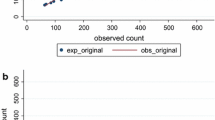Abstract
Objective: Identify factors associated with knowledge of breast cancer and estimation of risk.
Methods: Telephone survey of 412 women aged 40 and over, living in Montreal and selected by random digit dialing.
Results: The majority of the respondents had recently been exposed to some information on breast cancer, but only a third quoted the average lifetime probability estimate of about 1 in 10. Older individuals systematically considered themselves at low risk (odds ratio (OR) of perceiving risk as lower than average for women aged 50 or over versus under 50: 2.6, 95% confidence interval: (1.5,4.6)). In addition, both a firstdegree family history of breast cancer (OR: 5.3 (1.7,17.0)) and a recent mammogram (OR: 3.0 (1.4,6.2)) were strongly associated with a woman’s probability of perceiving herself at high risk.
Conclusions: Information campaigns should emphasize the frequency of breast cancer in different age groups and the strength of the established associations with specific risk factors. Better knowledge of risk could promote sustained participation in breast screening programs.
Résumé
Objectif: Identifier les facteurs associés à la connaissance du cancer du sein et à la perception du risque de cette maladie.
Méthode: Entrevue téléphonique auprès de 412 femmes âgées de 40 ans ou plus, résidant à Montréal et sélectionnées de façon aléatoire.
Résultats: La majorité des répondantes avaient été exposées récemment à de l’information concernant le cancer du sein, mais seulement le tiers d’entre elles connaissaient la probabilité moyenne de cette maladie au cours de la vie, environ 1 sur 10. Les femmes plus âgées se considéraient systématiquement à faible risque (rapport des cotes (OR) de se percevoir à faible risque pour celles de 50 ans ou plus versus celles de moins de 50 ans: 2,6, intervalle de confiance à 95 %: (1,5, 4,6)). De plus, une histoire de cancer du sein chez une parente au premier degré (OR: 5,3 (1,7, 17,0)) et une mammographie récente (OR: 3,0 (1,4, 6,2)) étaient fortement associées à la probabilité de se considérer à risque élevé.
Conclusions: Les campagnes d’information devraient faire connaître la fréquence du cancer du sein dans différents groupes d’âge et la force des associations démontrées avec des facteurs de risque spécifiques. Une meilleure connaissance du risque est susceptible de stimuler la participation soutenue au dépistage.
Similar content being viewed by others
References
Becker MH (Ed.). The health belief model and personal health behavior. Health Educ Monogr 1974;2:324–473.
Janz NK, Becker, MH. The health belief model: A decade later. Health Educ Q 1984;11:1–47.
Evans DGR, Burnell LD, Hopwood P, Howell A. Perception of risk in women with a family history of breast cancer. Br J Cancer 1993;67:612- 14.
Claus EB, Risch N, Thompson, WD. Genetic analysis of breast cancer in the Cancer and Steroid Hormone Study. Am J Hum Genet 1991;48:232–42.
Lerman C, Lustbader E, Rimer B, et al. Effects of individualized breast cancer risk counseling: A randomized trial. J Natl Cancer Inst 1995;87:286–92.
Gail MH, Brinton LA, Byar DP, et al. Projecting individualized probabilities of developing breast cancer for white females who are being examined annually. J Natl Cancer Inst 1989;81:1879–86.
Black WC, Nease RF, Tosteson ANA. Perceptions of breast cancer risk and screening effectiveness in women younger than 50 years of age. J Natl Cancer Inst 1995;87:720–31.
Dubin N, Pasternack, BS. Risk assessment for case-control subgroups by polychotomous logistic regression. Am J Epidemiol 1986;123:1101–17.
Fischhoff B, Bostrom A, Quadrel, MJ. Risk perception and communication. Annu Rev Public Health 1993;14:183–203.
Bar-Hillel M, Fischhoff B. When do base rates affect predictions? J Personality Soc Psychol 1981;41:671–80.
Kash KM, Holland JC, Halper MS, Miller, DG. Psychological distress and surveillance behaviours of women with a family history of breast cancer. J Natl Cancer Inst 1992;84:24–30.
Lerman C, Daly M, Sands C, et al. Mammography adherence and psychological distress among women at risk for breast cancer. J Natl Cancer Inst 1993;85:1074–80.
Santé Québec; Bellerose C, Lavallée C, Chénard L, Levasseur M. (sous la direction de). Et la santé, ça va en 1992–1993? Rapport de l’Enquête sociale et de santé 1992–1993, Volume 1. Ministère de la santé et des services sociaux, Gouvernement du Québec, 1995.
Vogel VG, Graves DS, Vernon SW, et al. Mammographic screening of women with increased risk of breast cancer. Cancer 1990;66:1613–20.
Kaplan KM, Weinberg GB, Small A, Herndon JL. Breast cancer screening among relatives of women with breast cancer. Am J Public Health 1991;81:1174–79.
Hailey, BJ. Family history of breast cancer and screening behaviour: An inverted U-shaped curve? Medical Hypotheses 1991;36:397–403.
Stefanek ME, Wilcox P. First degree relatives of breast cancer patients: Screening practices and provision of risk information. Cancer Detection Prev 1991;15:379–84.
Mah Z, Bryant H. Age as a factor in breast cancer knowledge, attitudes and screening behaviour. CMAJ 1992;146:2167–74.
Breslow R, Kessler L. Knowledge of breast cancer risk, by age. J Natl Cancer Inst 1995;87:1109.
Bondy ML, Vogel VG, Halabi S, Lustbader, ED. Identification of women at increased risk for breast cancer in a population-based screening program. Cancer Epidemiol Biomarkers & Prev 1992;1:143–47.
Bondy ML, Lustbader ED, Halabi S, et al. Validation of a breast cancer risk assessment model in women with a positive family history. J Natl Cancer Inst 1994;86: 620–25.
Spiegelman D, Colditz GA, Hunter D, Hertmark E. Validation of the Gail et al model for projecting individual breast cancer risk. J Natl Cancer Inst 1994;86:600–7.
Author information
Authors and Affiliations
Corresponding author
Rights and permissions
About this article
Cite this article
Hébert-Croteau, N., Goggin, P. & Kishchuk, N. Estimation of Breast Cancer Risk by Women Aged 40 and Over: A Population-based Study. Can J Public Health 88, 392–396 (1997). https://doi.org/10.1007/BF03403913
Received:
Accepted:
Published:
Issue Date:
DOI: https://doi.org/10.1007/BF03403913




